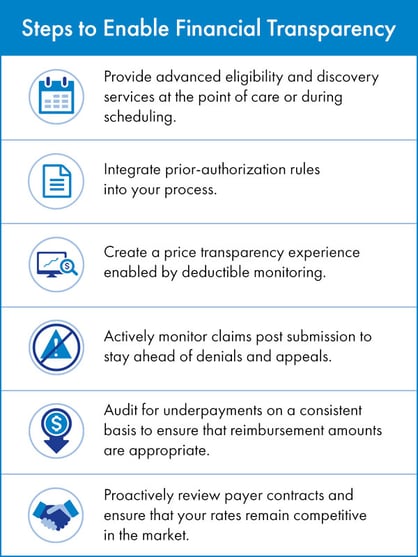Chart Smarter: Why One EMS Agency Ditched Paper for Mobile Tech
6 Steps to a Better Patient Experience Through Financial Transparency
When patients receive attention and care on the financial portion of medical care, along with quality patient care, it can reduce stress, promote healing, and vastly improve the patient experience
Was this information valuable?

When patients receive attention and care on the financial portion of medical care, along with quality patient care, it can reduce stress, promote healing, and vastly improve the patient experience.
A patient can have a great clinical experience only to have it ruined by a negative financial/billing experience. This scenario can be avoided when agencies incorporate financial transparency into their operations, according to EMS billing automation expert and director at ZOLL Data Systems, Alex Svitnev.
“Clinical transparency is achieved with stronger communications regarding follow-up care, timeline, and location. Financial transparency is another important part of the equation. Patients need to clearly understand why they need a procedure, specifics about the procedure and follow-up care, timeline, location, projected costs and what their out-of-pocket financial liability will be. This financial transparency can be a game-changer for agencies looking to reach a higher level of operational effectiveness and patient satisfaction,” says Svitnev.
How To Achieve A Better Overall Patient Experience
There are six key actions that contribute to improved financial transparency for patients and a better overall patient experience.
- Explain the root cause of the treatment. Reasons for healthcare services may be obvious to a provider but unclear to patients. Providers can mitigate patient fear or confusion by explaining why the procedure is needed and how it would be covered by the insurance company.
- Identify responsibilities. It’s helpful to explain the responsibilities of the provider, the payer, and the patient.
- Provide procedure specifics. A medical procedure can be a scary experience for a patient. Concerns can be alleviated by providing specific information on the procedure, the problem it will solve, and financial requirements.
- Explain the timeline. Providers can brief patients on when the procedure should take place, the length of the actual procedure, follow-up care requirements, payment deadlines, and more.
- Outline location options. For non-emergency care, patients can be briefed on location options where the procedure can be performed, along with what insurance would cover when transportation is needed.
- Provide cost estimates & payment details. Given the large number of patients with high-deductible health insurance, it’s critically important to address costs of the procedure, payment deadlines, payment plan options, and how to prevent overbilling.
Agency Strategies That Contribute To Financial Transparency

Communications with patients are key to financial transparency. In addition, there are specific operational strategies agencies can implement that contribute to a better patient experience and better transparency. They include:
- Provide advanced eligibility and discovery services at the point of care or during the scheduling of the procedure. Obtaining this information early allows agencies & providers to get ahead of prior-authorization rules while also providing patients with the most up-to-date payment estimate.
- Integrate prior-authorization rules into your process. Authorization determination typically is straightforward since most payers post these rules publicly. You can automate this routine process by having an eligibility process that feeds directly into prior-authorization determination and submission.
- Create a price transparency experience enabled by deductible monitoring. With the “No Surprises Act,” it will become increasingly important that patients understand the cost of care before a service is rendered. This is facilitated by ensuring that your process accounts for outstanding claims and current out-of-pocket limits.
- Actively monitor claims post submission to stay ahead of denials and appeals. Staying ahead of potential denials helps minimize patient stress. Waiting for an official denial letter rather than an EDI status could slow down reimbursement and delay the patient statement.
- Audit for underpayments on a consistent basis to ensure that reimbursement amounts are correct. An incorrectly applied underpayment could result in the patient being billed for the balance. This contributes to significant dissatisfaction when the actual billing statement exceeds the initial cost estimate for the procedure.
- Proactively review payer contracts and ensure that your market rates remain competitive in the market. Appropriate reimbursement levels provide the financial freedom to reinvest back into operations and better differentiate your medical services from the competition.
Healthcare that is transparent and focused on the treating the whole patient as a unique individual — physically, mentally, and financially — provides a better patient experience that promotes healing and recovery. This approach also provides opportunities for providers to become more efficient, profitable, and more competitive — especially when they deploy interconnected data between the ambulance agency and the hospital so EMS can bill for services correctly.
Learn more about creating improved financial transparency for patients, while also improving their own operations by watching the complimentary webinar with Alex Svitnev, Serving Patients Through a Better Experience.
Read more about improving the patient financial experience:
The Transformational Effects of Charitable Financial Screening for ASCs
Related Posts
The End of Delayed Documentation
4 Must-have Data Points for Dispatch-Billing Alignment and Maximum Reimbursement
ZOLL Pulse Blog
Subscribe to our blog and receive quality content that makes your job as an EMS & fire, hospital, or AR professional easier.
ZOLL Pulse Blog
Subscribe to our blog and receive quality content that makes your job as an EMS, fire, hospital, or AR professional easier.




